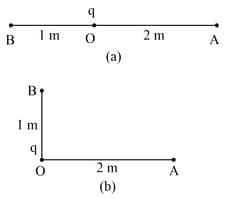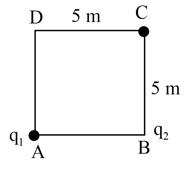A charge is held at between the points and such that and , as shown in Fig. (a). Calculate the potential difference . What will be the value of the potential difference if the position of is changed, as shown in Fig (b)



Important Questions on Electrostatic Potential and Capacitance
Two small spheres of radius each carrying charges and are placed at points and distance apart. Calculate the potential difference between points and .
The sides of rectangle are and , as shown in Fig. Point charges of and are placed at the vertices and respectively. Calculate electric potentials at the vertices and . Also calculate the work done in carrying a charge of from to .

Charges of and are placed at the corners and of a square of side , as shown in Fig. How much work will be done in moving a charge of from to against the electric field?

Charges of are placed respectively at the corners and of a rectangle . Determine the potential at the corner . Given and .
Positive charges of and are placed at the three vertices of a square. What charge must be placed at the fourth vertex so that total potential at the centre of the square is zero?
Two equal charges, each are held fixed at a separation of . A third charge of equal magnitude is placed midway between the two charges. It is now moved to a point from both the charges. How much work is done by the electric field during the process?
